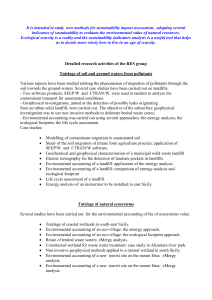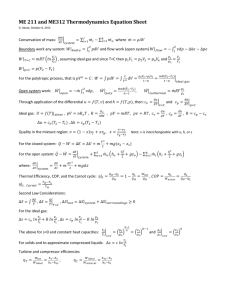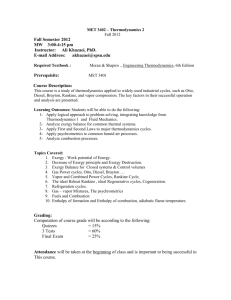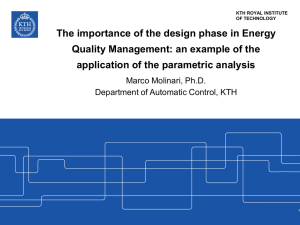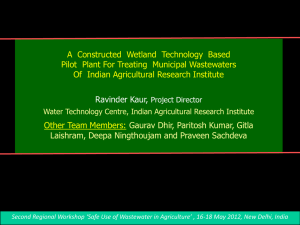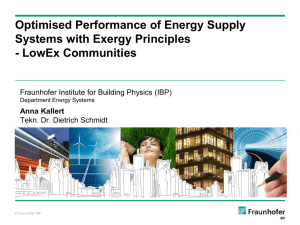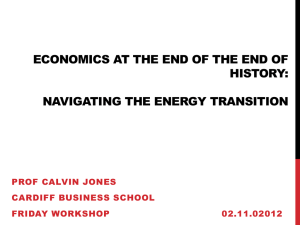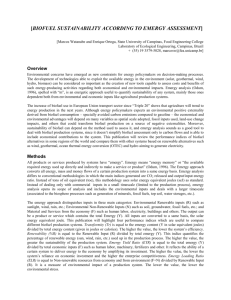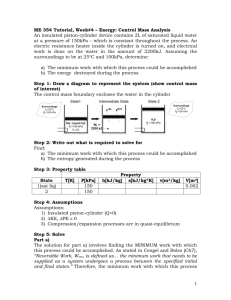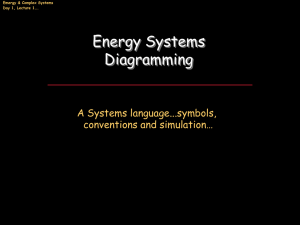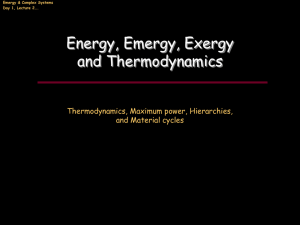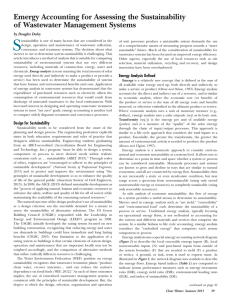Physics concepts in educational issues: from the energy systems
advertisement
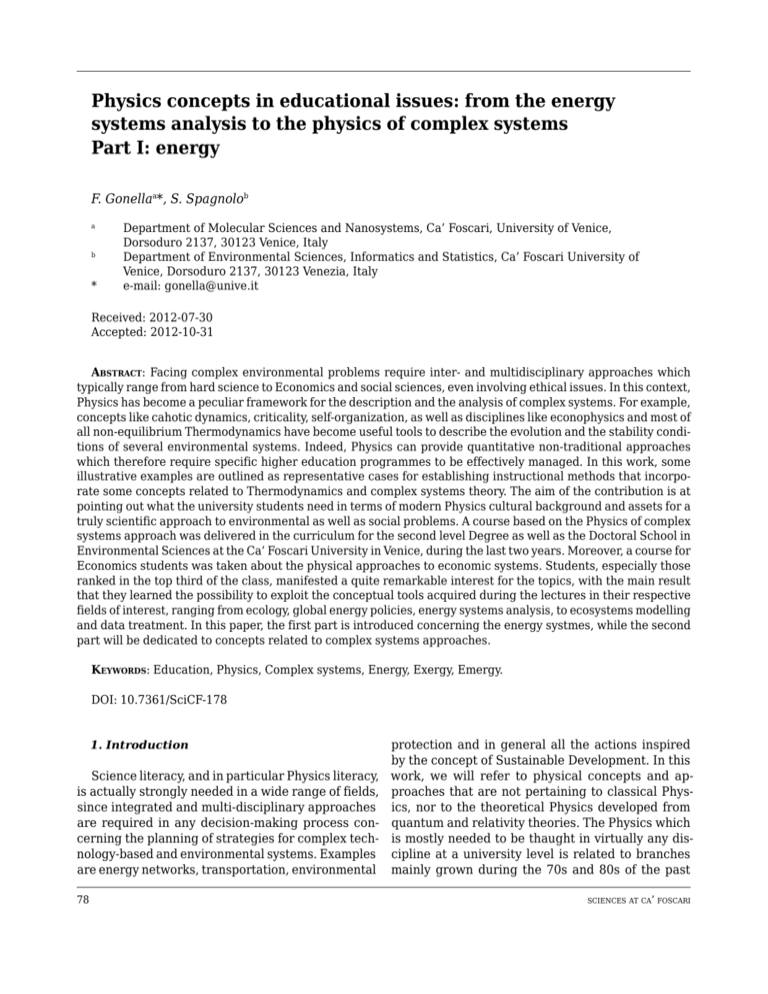
Physics concepts in educational issues: from the energy systems analysis to the physics of complex systems Part I: energy F. Gonellaa*, S. Spagnolob a b * Department of Molecular Sciences and Nanosystems, Ca’ Foscari, University of Venice, Dorsoduro 2137, 30123 Venice, Italy Department of Environmental Sciences, Informatics and Statistics, Ca’ Foscari University of Venice, Dorsoduro 2137, 30123 Venezia, Italy e-mail: gonella@unive.it Received: 2012-07-30 Accepted: 2012-10-31 Abstract: Facing complex environmental problems require inter- and multidisciplinary approaches which typically range from hard science to Economics and social sciences, even involving ethical issues. In this context, Physics has become a peculiar framework for the description and the analysis of complex systems. For example, concepts like cahotic dynamics, criticality, self-organization, as well as disciplines like econophysics and most of all non-equilibrium Thermodynamics have become useful tools to describe the evolution and the stability conditions of several environmental systems. Indeed, Physics can provide quantitative non-traditional approaches which therefore require specific higher education programmes to be effectively managed. In this work, some illustrative examples are outlined as representative cases for establishing instructional methods that incorporate some concepts related to Thermodynamics and complex systems theory. The aim of the contribution is at pointing out what the university students need in terms of modern Physics cultural background and assets for a truly scientific approach to environmental as well as social problems. A course based on the Physics of complex systems approach was delivered in the curriculum for the second level Degree as well as the Doctoral School in Environmental Sciences at the Ca’ Foscari University in Venice, during the last two years. Moreover, a course for Economics students was taken about the physical approaches to economic systems. Students, especially those ranked in the top third of the class, manifested a quite remarkable interest for the topics, with the main result that they learned the possibility to exploit the conceptual tools acquired during the lectures in their respective fields of interest, ranging from ecology, global energy policies, energy systems analysis, to ecosystems modelling and data treatment. In this paper, the first part is introduced concerning the energy systmes, while the second part will be dedicated to concepts related to complex systems approaches. Keywords: Education, Physics, Complex systems, Energy, Exergy, Emergy. DOI: 10.7361/SciCF-178 1. Introduction Science literacy, and in particular Physics literacy, is actually strongly needed in a wide range of fields, since integrated and multi-disciplinary approaches are required in any decision-making process concerning the planning of strategies for complex technology-based and environmental systems. Examples are energy networks, transportation, environmental 78 protection and in general all the actions inspired by the concept of Sustainable Development. In this work, we will refer to physical concepts and approaches that are not pertaining to classical Physics, nor to the theoretical Physics developed from quantum and relativity theories. The Physics which is mostly needed to be thaught in virtually any discipline at a university level is related to branches mainly grown during the 70s and 80s of the past sciences at ca’ foscari Century. This body of knowledge takes its roots from the theory of complex systems, the non-equilibrium Thermodynamics, the theory of Chaos, the catastrophes theory, and in general from the observation that several phenomena in different contexts exhibit the same physico-mathematical description, so that features like self-organization, critical instability, generalized phase transitions, emergent properties, hierarchical self-arrangements are suitable to be studied by means of proper isomorphisms of the respective variables and concepts. Being a complex system composed of interconnected parts that as a whole exhibit “collective” properties not deducible for the individuals behavior, it is clear how ant colonies, community economies, climate, energy and telecommunication network and systems share several features and behaviors that may be therefore framed in the same analyical approaches. As pointed out by David Goodstein, as a matter of fact 95 percent of the American public is illiterate in science by any rational definition of science literacy [1]. But if science illiteracy is a problem at a general level, the lack of knowledge about the above mentioned topics could deprive the decision makers, at any level, of critically precious tools for an effective planning in the socio-economical context [2]. This point has been addressed in the World Conference on Physics and Sustainable Development [3], where one the goals in the Conference Resolutions is explicitly “To develop supplemental instructional materials for secondary physics courses that help students understand how the mastery of Physics concepts can enable them to contribute to sustainable development in their own Countries”. Table 1 lists – though certainly not compre-hensively – the subject and concepts that will be treated in the two parts of this article, along with a list of fields in which they are used. This latter list points out in turn the most important disciplines which the concepts should enter in the educational activity at a university level. It is worth stressing that non-equilibrium Thermodyamics is in particular suitable to be learned as one of the most general disciplines. In spite of its historical foundation as an engineering discipline aimed at determining the efficiency of engines, it assumed straightaway the status of a deeply abstract approach in the study of virtually any element of Nature, mainly starting from the work of Ludwig Boltzmann about the link between entropy and probability, framed in the famous formula S=k·logW. Thermodysciences at ca’ foscari namics abstraction has been in fact effetively used to build up isomosphisms between thermo-dynamical quantities and laws and corresponding concepts pertaining to very different fields, for example, biology, etology, information theory, macroeconomics, social sciences [4]. Table 1. Physics-related subjects, concepts and fields. (Non-equilibrium) Complex systems Subjects thermodynamics - State space - Feedback - Entropy - Self-organization - Energy - Emergent properties - Exergy Concepts - Criticality - Emergy - Chaotic dynamics - Catastrophe - Space state trajectory - Attractor - Generalized forces - Bifurcation and flows - Adaptive system - Thermodynamic - Non-linear system Derived probability - Sensitivity concepts - Macro and microstate - Critical state - Stationary state - Fractal dimension - Scale invariance - Sustainable development - Ecosystems analysis - Environmental Economics Fields - Environmental policy - Energy systems and networks analysis 2. Energy systems and networks Challenges related to the energy problem have drawn in recent years an enormous attention, mainly for the issues connected to climate changes, impoverishment of the fossil energy sources, globalization and in general to the sustainable development, which not more than 25 years ago was just unknown to the most. The need for an integrated approach in the management of energy production and distribution is witnessed by the proliferation of dedicated research Journals as well as by the several programmes established by both governmental and global Agencies and Institutions (see for example the Intelligent Energy Europe Programme [5]). Various initiatives are explicitly recommended in this sense, for example, the development of planning and management tools for calculating energy balance, self-supply energy networks, integration of renewable energy technologies, energy smart buildings, electricity use efficiency, and in general energy sustainability. In particular, the assessment of methodologies able to evaluate the suitable pathways to 79 renewable and efficient energy systems are strongly needed. All these factors address the need for an integrated energy-related cultural framework for scientists, engineers, economists and policy makers, as demonstrated for example by the fruitless debate that accompanied the nuclear energy option for literally decades. In this sense, a background of Physics-based concepts seems to be necessary for a comprehensive understanding of the energy problem whatsoever. Even though specific educational programmes have entered several multi-national projects (see for example [6]), academic Institutions tend to maintain traditional programmes without that trans-disciplinary character which appears to become more and more essential. Among them, recent papers by Jacobson and Delucchi [7,8] describe a transition towards a global energy supplied by wind, water, and solar power, taking into account, besides the energy resources per se, a comprehensive analysis of quantities and areas of infrastructure, materials, reliability, system and transmission costs, and policies. The somewhat surprising conclusion of the work is that “barriers to a 100% conversion to WWS power worldwide are primarily social and political, not technological or even economic” [8], thus dramaticaly underlining the strong need for both a scientific and a non-scientific integrated approach to the problem. Generally speaking, energy networks planning is determined by both the culture of a society and the available technologies, which along with the geographical constraints come to select suitable alternatives. The choice and the realization of the energy system is based as a matter of fact on the ethical values system, on the security necessity and most of all on the policies that can provide economic and/or social incentives. Energy, measured in Joule (J), is the mathematical function quantifying the capability to perform work. It may exhibit different forms, which are usually distinguished depending on the way each of them provides useful work for human activities, so that one talks of electric energy as well as mechanical, nuclear, electromagnetic, thermal, potential, chemical energy, etc.. The energy of the Universe is conserved (1st principle of Thermodynamics), in the sense that it can be transformed from one form to culture another, transferred, stored but not created nor geographical features destroyed. Despite this, a sort of “degradation” technology of the energy resource is however unavoidable, following the 2nd principle of Thermodynamics, which addresses the irreversible increase of alternative projects entropy in a closed system. From the point of view of human activities involving energy processes and flows, it is more useful to differentiate the security ethics policies energy forms depending on their use. Typically, energy is then considered as: Primary (solar, geothermal, planetary, fuels); Secondary (at realization of conversion stations); Final (electricity, gasoline energy network at user); Useful (converted energy at user), and Rejected (in the environment). This classification shifts the attention toward the processes rather alternative Sustainable than the forms, but what is important to point scenarios Development out is that any energy system analysis require methodologies that take into account factors and aspects belonging to traditionally nonFig. 1. Energy network settlement issues. communicating disciplines. In the last years, several papers were published describing possible Depending on the risk factors acting at different scenarios -at different geographical levels- for scales (climate changes, geochemical cycles modifithe conversion of energy supply networks based cations), it is necessary to consider alternative sceon fossil fuels to renewable sourcesbased ones. narios and to perform environmental impact assess80 sciences at ca’ foscari ments at any level (including life cycle assessment, ecological footprint, etc.), such to make the energy planning of a territory ecologically compatible and consistent with the principles of sustainable development. Figure 1 shows a synoptic scheme reporting the logical connection between different realms participating in the definition of the energy problem. As already pointed out, there is a strong need for quantities and indices able to quantify and address an effective computation of the efficiency of the energy systems. In the following, the concepts of Exergy and Emergy are introduced, with some short examples of their suitability in energy systems analysis. Indeed, exergy and emergy are two concepts related to the actual capability of exploiting the energy provided by a source, or flowing toward the end user. Quite surprisingly, both of them are still rarely referred to when dealing with energy networks and systems, whereas the energy flow analysis could be effectively compared for example to the analysis of the exergy flow for a better understading of the real feasibility and the real efficiency of a system. 3. Exergy The concept of exergy has been defined first by Zoran Rant [9] back in 1953, to indicate the “technical working capacity”, so intending to quantify the connection between a system and its environment in terms of the actual work available from a certain energy flow. Other definitions of exergy have been afterwards proposed [10-12]. The exergy of a system in an environment may be defined as the maximum mechanical work that can be extracted from the system in that certain environment, while from the point of view of its role in the energy processes, it is that part of energy that is convertible into all other forms of energy. From a physical point of view, while energy cannot be produced nor consumed, exergy can actually be destroyed, since it has to do with the quality of energy forms. Exergy may be also connected to entropy, in the sense that exergy consumption is related to the irreversible increase of entropy for the couple system+environment [13]. The advantage in developing a system analysis in terms of exergy is that both energy (in its various forms) and materials can be regarded as exergy carriers, each one labeled with a “quality index”, expressed by the percentage of exergy with respect to its energy content. This may sounds awkward in sciences at ca’ foscari the case of matter, but it must be considered that the chemical form of materials can play the crucial role in energy-producing systems; the typical example is in batteries, that provide electric energy by operating a change in the form of the matter which are made of. As pointed out by Wall [10], the exergy content in a certain material can be regarded as the energy needed to fabricate this material from the given environment by reversible processes. It is worth remarking that this approach is conceptually close to the Life Cycle Assessment, which -in defining the impact of a product or service- takes into account all its life cycle, from the raw materials extraction to its final withdrawal. Chemical exergy is carried by biological matter, too. In this case, also the so-called structural exergy may be taken into account, for food consumption involves both the chemical trans-formation related to the metabolism and the possibility of using aminoacids as building blocks for the body tissues. To give an example of exergy-based analysis, let us compare energy and exergy flows for a power plant, e.g., a coal plant, which transforms the coal chemical energy into heat, then used to create high pressure vapour, which converts the energy in mechanical motion by means of a turbine, and is finally used to produce electric energy. power plant energy flow chemical energy steam motion electricity friction heat exhaust power plant exergy flow chemical exergy steam motion heat electricity friction exhaust Fig. 2. Energy (above) and exergy (below) flows for a coal power plant. 81 In fig. 2, (adapted from [10]), the Sankey diagrams are shown for both energy and exergy flows. Total input and output in the two cases are equal, since we are dealing here with high quality energy forms. Without entering technical details, what appears anyway quite different is the role of the processes that decrease the energy and the exergy outputs (note that, contrary to the case of energy, exergy is actually destroyed). While the energy analysis indicates that the heaviest loss occurs in the heat-exchanger that cools the water, exergy appears to be mostly lost internally, thus indicating where new technical solutions must be addressed for a better efficiency of the plant. What is much interesting is that the exergy concept assumes an analytical form, so making it available for quantitative studies. Let us take a system that can exchange heat, work and matter with an environment whose intensive quantities are then supposed to be constant. All spontaneous processes that take place involving energy and/or matter exchange may be used in principle for obtaining mechanical (high quality) energy, as far as the equilibrium is not reached. Exergy may be expressed in the form [14]: Ex = U – U0 + P0 (V – V0) – T0 (S – S0) – ∑i µi (ni – ni0) where T, P and mi are temperature, pressure and chemical potential (for the i-th species) of the system, respectively, while V, U, S and ni are the extensive properties, namely, its volume, internal energy, entropy and number of moles (of the i-th species), respectively. The corresponding zero-ed terms are the values of the respective variables when the equilibrium is reached. The four terms on the right side represent in turn the variation of the internal energy, the work coming from a volume change due to a pressure gradient, the heat exchanged (calculated along a reversible trans-formation) and the work related to matter migration, respectively. It is worth noting that this expression goes to zero when the system+environment ensemble reaches the final equilibrium state. It is possible to see that the energy actually converted into mechanical or electric work comes out to be always less than the exergy, since its expression takes into account all the (not exploitable) energy/matter exchange between system and environment, and at the same time uses an ideal heat exchange without entropy production. Thus, exergy can be actually used as an effective index for determining the real efficiency of a process. Since exergy of something -as said- may be linked 82 to the exergy cost for fabricating that something, it is clear that the flow of resources themselves mat be described from an exergetic point of view. In this respect, international trade can therefore be analyzed in the framework of exergy exchange and consumption. This is furthermore interesting since the exergy needed to the production of a certain material, good or service is different depending on the production site, that is, its production environment. So, exergy-based analyses not only can shed further light on the global efficiency of energetic systems, but also address where and how to operate technical interventions. Though difficult to be comparatively assessed for different environments, exergy concept is so closely related to the human sociaty and activities that it should certainly be introduced in any curriculum Degree dealing with environmental problems, from Science to Economics. In particular, no student should graduate from any high educational Institution without a basic comprehension of Thermodynamics, focused on energy and matter flows. A dedicated course should be delivered especially in these disciplines that, even starting from a non-scientific framework, come to face the technical and abstract approaches from Physics. Needless to say, any specific Sustainable Development programme will also include this kind of thermodynamical approach in the study of energy systems and networks, tailored on the scientific (physical) background of the students. 4. Emergy The concept of Emergy (from “Embodied Energy”) as a quantity suitable to quantify the “real” wealth and the “real” standard of living is dated back to the 70s. Its suitability to account for how much energy is actually embedded in a product or service comes from the observation that when different energy sources are used at the same time, their differences in quality must be considered in the evaluation of the actual energy costs, since the capability to perform work depends on the quality of the energy provided by a source. Howard T. Odum was the first to put the basis for emergy analyses [15], defining emergy as “the available energy of one kind that is used up in transformations directly and indirectly to make a product or service”. In this respect, emergy quantifies how much energy has been used to build something, and so it can be regarded as the “memory” of its building up, that is, as how much energy is emsciences at ca’ foscari bedded in a product or service. The unit of emergy is from a physical point of view the same of energy but is called emjoule (eJ), that tells us the available energy of one kind consumed in transformations. Emergy then allows to analytically compare any kind of energy, energy source or service by expressing them in a common baseline, usually that of solar emergy, by computing the emjoules of solar energy required to produce any of the respective contributions to an energy system or network, as well as in general to any energy-related human activity. Emergy approach requires some further definitions, among which the “transformity” plays an important role, defined as the emergy input per unit of available energy output. All calculations are made assuming that the solar transformity (in units named solar emjoules, seJ, per J) of the sunlight absorbed by the Earth is 1 seJ/J. Material resources are accounted for as well, since energy is spent to concentrate the materials (in space as well as in their usable chemical form), through the definition of specific emergy, in seJ/g, equal to the emergy per unit of product mass. Empower is then the intensive quantity connected with the above mentioned ones. It is defined as the emergy flow (released or used) per unit time, being thus expressed in seJ/s or seJ/yr. What takes the emergy concept outside the realm of traditional science is the concept of emergy per money unit, that is the emergy related to the generation of one unit of economic product (in currency), allowing one to convert (even somewhat not univocally) money transfers into emergy units. In this way, the role played in an energy flow process by monetary transfers turns out to be the purchased emergy, since the environment does not participate to monetary transfers [16]. In this way, the actual available resources may be effectively quantified by the emergy availability, besides of course the money one. A solar emjoules/currency index can be then defined, as the total emergy use of a community over its gross domestic product (GDP). For example, every dollar spent in United States economy has embodied in it 1012 seJ of emergy [17]. It has been observed that this index is related to the inflation, thus measuring the real wealth, whereas the emergy per person is a measure of the standard of living, that in turn may be expressed in “em€”, or “em$”, units. As a matter of fact, Countries living more on local resources than purchased goods have higher emergy to dollar ratios, whereas trading disparity is actually driven by emergy consumption unbalance. sciences at ca’ foscari Fig. 3. Emergy diagram for the biofuel production activity. surface water wind goods fuels geological processes rain services $ water soils agricultural crop assets transport processing $ fermentation distillation wastes degraded energy biofuel $ Sun Operatively, system diagrams are drawn accounting for all inputs and outputs carrying emergy flows, from which quantitative results may be obtained by exploiting some performance indices: • Emergy Yield Ratio (EYR) = Total emergy used per unit of emergy invested. This is a measure of how much an investment allows a process to use local resources. • Environmental Loading Ratio (ELR) = Nonrenewable and imported emergy over renewable emergy. This is very similar in its effectiveness to indices used for evaluating an ecosystem stress. • Emergy Sustainability Index (ESI) = The ratio of the two indices above, giving a measure of how much a resource or process contributes to the economy per unit of environmental loading. As an example, fig. 3 reports the diagram accounting for the biofuel production activity [18] (courtesy of Prof. M.T. Brown, University of Florida). Symbols have the following meaning: circles are the sources (forcing functions), shields are the tanks, bullets are the producer units (collect and transform energy) and diamonds indicate money transfers. 83 By analyzing the flows the above mentioned indices may be estimated, from which suitable information for an efficient planning policy can be assessed. Emergy diagrams can be actually set at any level of analysis. Figure 4 [18] illustrates more generally the empower supporting the geobiosphere. The quantitative annual emergy flows are also indicated, in 1024 seJ units [17]. Earth heat Sun-Moon (tides) Sun 3.9 3.8 8.1 atmosphere fossil fuels 34.3 5. Discussion and Conclusions crust heat oceans human activity degraded energy Fig. 4. Empower supporting the geobiosphere. Emergy considerations also enter in the behavior description of complex systems in terms of selforganization: in particular, a principle has been proposed called “Maximum empower principle”, describing how a system network spontaneously evolves towards evolution paths which maximize the empower, at any hierarchical level. Indeed, selforganization seems to give rise to network parts connections, by spontaneously tailoring feedbacks between the different emergy exchanges in the system. As Odum himself says [19], “In time, through the process of trial and error, complex patterns of structure and processes have evolved (...) the successful ones surviving because they use materials and energies well in their own maintenance, and compete well with other patterns that chance interposes”. Actually, systems can maximize empower for example by storing high-quality energy and then feeding it back to inflows, as well as by recycling materials, building up stability control mechanisms, and all these contribute, when properly included in 84 the emergy system diagram, to a realistic description and analysis of the system at issue. Even if literature has proposed many emergy-based evaluations of systems and processes (for a comprehensive bibliography, see [20]), teaching emergy as a tool for energy production, energy network and energy plants evaluation is still quite uncommon. One of the main reasons for including emergy-based approaches in the high education programmes is that emergy analysis is the way to refer explicitly to the role of environment in the definition and planning of systems, processes, and products involving energy exchanges and flows, whereas traditional economic analysis, which accounts for money transfers and so it is anthropocentric by definition, may actually take advantage from an intrinsically different point of view such that introduced by emergy methodology. The environmental system provides the society of either renewable or non-renewable sources which, through various processes, convert the primary energy in energy directly usable by commercial, residential and industrial users as well as in the transportation sector, under the forms of heat, electricity or mechanical energy. Figure 5 illustrates synoptically the complex grid of interconnections which have to taken into account when dealing with energy systems. Energetic conversion takes place in plants which utilize goods and services provided by both the “Society system” and the “Environment system”. For example, the environmental support is made by the oxygen needed for combustion processes, fresh water and air, areas occupation, environmental dispersion and absorption of emissions and wastes. Emergy analysis allows, along with the analysis of mater and energy flows, to evaluate and compare the global environmental sustainability of the various energy sources, from the point of view of the donor (donor-side quality), quantitatively estimating the resources and the services that cannot be estimated directly by an economic approach, for example, the biodiversity [21]. From the user point of view (user-side quality) the used approach should not be (only) emergy-based, but rather exergy-based, taking so into account what the technologies may extract from the different energy sources, without considering directly the free services offered by the environment and that are needed for the producsciences at ca’ foscari tion processes [22]. The outputs of the conversion processes consist of secondary energy (electricity, gasoline), pollutants emissions, wastes and energy losses (low exergy content). The secondary energy so obtained must be conveyed in a proper transmission and distribution structures, in order to reach free environmental services the final users or the stocking systems in the case of intermittent sources (wind, sun, etc.). It is then necessary to plan a long-term, globalscale restructuring of the transmission-distribution networks, so creating a supergrid through the geographical interconnection of the renewable energy goods services buildings renewables users primary energy conversion commerce industry transportation nonrenewables secondary energy distribution EMERGY useful energy final energy EXERGY emissions storage waste lost energy geographical features policies ethics technology target security energy flow matter flow information flow ENVIRONMENTAL SYSTEM Fig. 5. The global energy network. sources, such to guarantee the continuous supply of electricity to the final users. Concepts taken from modern Physics topics have been more and more used in different scientific and non-scientific disciplines. Their use derives from two general aspects. The first is the possibility of define isomorphisms between quantities and relations of Physics and those of the discipline at issue. The paradigmatic example is Thermodynamics and Economics. The second is the direct application of a certain “physical” approach to the study of a non-physical sciences at ca’ foscari culture alternative scenarios SOCIAL SYSTEM system. Several examples can be found in current approaches to the analysis of complex systems, among which the energy ones. In this work, exergy-based and emergy-based approaches have been outlined for the study of energy systems, pointing out how the use of these concepts may actually shed light to the role played by the various components of these systems. In particular, social, economic and most of all environmental issues may find there place in an analytical quantitative approach which the planning of energy systems should be based on. 85 As concerns the educational prescriptions suggested by the presentation above, some concepts appear to be necessary in the cultural background of any student involved in environmental issues. As a matter of fact, students graduate without any integrated awareness of the unity of things. In the words of David Orr, “To teach Economics, for example, without reference to the laws of Thermodynamics or those of ecology is to teach a fundamentally important ecological lesson: that Physics and Ecology have nothing to do with the Economy. That just happens to be dead wrong” [23]. The novel attention drawn in Ca’ Foscari University towards a sustainable Institution is actually an important step forward for creating an environmental awareness also in the students. A more effective awareness and most of all an effective scientific literacy on the sustainability problem require on the other hand the establishment of curricula that involve interdisciplinary courses, seminars and lectures. The following items, related to the content of this paper, should be therefore delivered within the curricula of students of any scientific discipline, as well as -more ambitiously- human, economical and social sciences: • • • • • first and second principles of Thermodynamics; concepts of entropy, energy, exergy and emergy; their relation with the environment; their relation with the human activity; flows analysis. 6. References [1] [2] [3] D. Goodstein, J. Sci. Educ. Technol. 1992, 1, 149-155. P. Campbell, Phys. Edu. 2006, 41, 514-517. World Conference on Physics and Sustainable Development, Durban, South Africa 2005, www.wcpsd.org/upload/Resolutions-Final.pdf. [4] N. Georgescu-Roegen, in Entropy and Bioeconomics, Proc. 1st International Conference of the E.A.B.S. (Eds.: J. Dragan, E. Seifert, M. Demetrescu), European Association for Bioeconomic Studies, Milan, 1993, pp. 184201. [5] http://ec.europa.eu/intelligentenergy. [6] www.iee-library.eu. [7] M.Z. Jacobson, M.A. Delucchi, Energy Policy 2011, 39, 1154-1169. [8] M.A. Delucchi, M.Z. Jacobson, Energy Policy 2011, 39, 1170-1190. [9] Z. Rant, Forschung auf dem Gebiete des Ingenieurwesens 1956, 22, 36-37. [10] G. Wall, Energy 1988, 13, 197-208. [11] H.D. Baehr, Energie und Exergi, VDI-Verlag, Düsseldorf, 1965. [12] M. Tribus, E.C. McIrvine, Sci. Am. 1971, 224, 179-186. [13] N. Georgescu-Roegen, , Harvard Univ. Press, Cambridge, 1971. [14] J. Szargut, Exergy Method - Technical and Ecological Applications, WIT Press, Southampton, 2005. [15] H.T. Odum, Environment, Power and Society, Wiley, New York, 1971. [16] H.T. Odum, Environmental Accounting: Emergy and Environmental Policy Making, Wiley, New York, 1996. [17] H.T. Odum, M.T. Brown, S.B. Williams, Handbook of Emergy Evaluation: A Compendium of Data for Emergy Computation Issued in a Series of Folios, 2000, www. enst.umd.edu/tilley/emergy/. [18] National Environmental Accounting Database, University of Florida, http://sahel.ees.ufl.edu/frame_database_re- In the forthcoming second part of this paper, the sources_test.php?search_type=basic. attention will be drawn to the concepts, taken from [19] www.eoearth.org/article/Howard_T._Odum_Collection. the “classical” complex systems analysis, mostly related to cahotic dynamics, self-organization, critical- [20] www.emergysystems.org. [21] M.T. Brow, S. Ulgiati, J. Cleaner Prod. 2002, 10, 321-334. ity and emergent properties. 5. Acknowledgement [22] M.T. Brown, S. Ulgiati, Ecological Modeling 2004, 78, 201-213. [23] D.W. Orr, Ecological Literacy: Education and the Transition to a Postmodern World, New York State University Press, New York, 1992. Prof. Roberto Pastres is acknowledged for having introduced the Authors to some of the cross-disciplinary approaches based on exergy and emergy. 86 sciences at ca’ foscari
